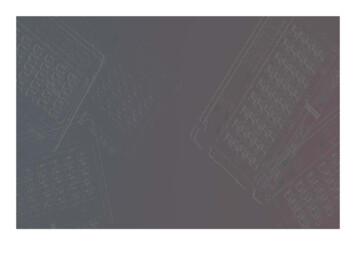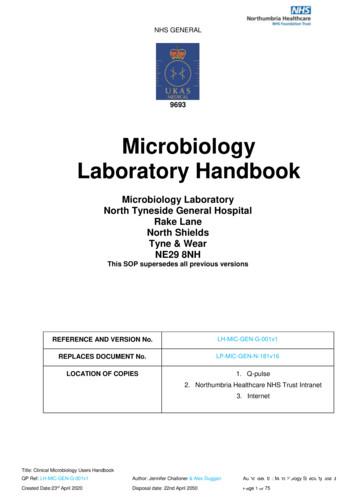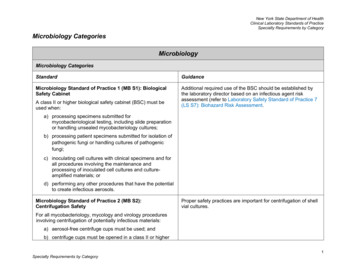Curriculum Of BS Microbiology - GCUF
Revised and UpdatedCurriculum of BSMicrobiologyTo be implemented fromFall 2018-19(Session 2018-22 onward)Department of MicrobiologyGovernment College UniversityFaisalabadAugust 20181
COURSE OUTLINESSemester 1S. NoCourse CodeCourse Title1MIC-301Introductory Microbiology3(2-1)2MIC-303Microbial Taxonomy3(3-0)3BCH-301Introductory Biochemistry4(3-1)4BOT-301Diversity of Plants4(3-1)5ISL-321Islamic Studies2(2-0)6ISL-322Ethics (For Non-Muslim only)2(2-0)7PST-321Pakistan Studies2(2-0)8ENG-321Functional English3(3-0)Total CreditCredit Hour21Semester 2S. NoCourse CodeCourse TitleCredit Hour1MIC-302Cell Biology3(3-0)2MIC-304Microbial Anatomy and Physiology3(2-1)3MIC-306Human Physiology3(2-1)4ZOL-301Principles in Animal Life-I4(3-1)5ENG-322English Comprehension and Composition3(3-0)6MTH-321Algebra and Trigonometry3(3-0)Total Credit19Semester 3S. NoCourse CodeCourse TitleCredit Hour1MIC-401Basic ycology3(2-1)2
4MIC-407Biosafety and Risk Management3(2-1)5ENG-422Technical Writing3(3-0)6CSI-321Introduction to Computing Applications3(2-1)Total Credit18Semester 4S. NoCourse CodeCourse TitleCredit Hour1MIC-402General sitology3(2-1)4MIC-408Epidemiology, Public Health and Bioethics3(3-0)5MIC-410Laboratory Animals and Model Organisms2(0-2)6STA-507Biostatistics3(3-0)Total Credit17Semester 5S. NoCourse CodeCourse TitleCredit Hour1MIC-501Systemic Virology3(2-1)2MIC-503Cell and Tissue Culture3(2-1)3MIC-505Microbial Genetics3(3-0)4MIC-507Molecular Biology and Biotechnology3(2-1)5MIC-509Food Microbiology3(2-1)6MIC-511Infectious Waste Management3(2-1)Total Credit18Semester 6S. NoCourse CodeCourse TitleCredit Hour1MIC-502Vaccinology3(2-1)2MIC-504Environmental Microbiology3(2-1)3
3MIC-506Medical Microbiology3(2-1)4MIC-508Veterinary Microbiology3(2-1)5MIC-510Microbial Enzymology3(3-0)6BIN-422Introduction to Bioinformatics3(2-1)Total Credit18Semester 7S. NoCourse CodeCourse TitleCredit Hour1MIC-601Diagnostic Microbiology3(2-1)2MIC-603Soil and Agricultural Microbiology3(2-1)3MIC-605Marine and Fresh Water Microbiology3(2-1)4MIC-607Pharmaceutical and Industrial Microbiology4(3-1)5MIC-609Genetic Engineering3(2-1)6MIC-611Research Methodology2(2-0)Total Credit18Semester 8S. NoCourse CodeCourse TitleCredit otal Credit6Grand Total1354
1 Semesterst5
MIC-301 Introductory Microbiology 3(2-1)Department of MicrobiologyGovernment College University FaisalabadCourse TitleCourse CodeCredit HoursTotal MarksContact HoursSemester DurationMid Term ExaminationFinal Term ExaminationInstructor NameSessionSemester (Morning/ Evening)ProgramIntroductory MicrobiologyMIC-3013(2-1)604 Hours Per Week (2 Hours Theory 2 Hours Practical)18 Weeks9th Week18th WeekDr. Muhammad Hidayat Rasool2018-221stBS MicrobiologyLearning Objectives of the Course1Course is designed to introduce students to the Science of Microbiology andmicroorganisms.2To give them an overview about the microbial world, scope and branches ofmicrobiology and basic knowledge of different microorganisms.3To theoretically and practically equip them with basic techniques used inMicrobiology.4To impart some preliminary knowledge about how to control microbial life and briefoverview of antimicrobial agents and antimicrobial drug resistance.5After this course students will be able to understand the detail knowledge andtechniques with respect to different microorganisms during specific courses in futuresemesters.Week1st2ndLecture/ PracticalCourse ContentsLecture-1Introduction and scope of MicrobiologyLecture-2Practical-1Branches of Microbiology and an overviewMicroorganismsLaboratory Safety: Containment and decontaminationLecture-3Historical Development in MicrobiologyLecture-4Historical Development in Microbiology (Continued)Practical-2Introduction to Microscopy: Parts and working of anofordinary bright field light microscope6
Lecture-53rdMicroscope & Microscopy: Principles, functions anddifferences of various types of light and electronmicroscopesLecture-6Classification and brief introduction of Microorganisms:Bacteria, Fungi, Algae, Protozoa, Parasites, Viruses susedinMicrobiologyLecture-74thNomenclature and general morphology (size, shape &arrangement) of microorganisms terialsandequipmentsusedinMicrobiology (Continued)Lecture-95thCellular morphology of Bacteria: structures external to cellwall & cell wallLecture-10Cellular morphology of Bacteria: structures internal to cellwall6th7th8thPractical-5Moist heat sterilization: Use of AutoclaveLecture-11Bacterial growth and growth curveLecture-12Growth rate, generation time and their calculationsPractical-6Dry heat sterilization: Use of Hot air ovenLecture-13AssignmentLecture-14Growth requirements of bacteria (Physical)Practical-7Preparation and sterilization of culture mediaLecture-15Growth requirements of bacteria (Chemical/Nutritional)Lecture-16Growth characteristics of bacteria on agar and in brothmedia9thPractical-8Preparation and sterilization of glass wareMid TermMid Term of 12 Marks (05 Marks objective) and (07 MarksExaminationLecture-17subjective)Culture Media: Classification, composition and use of7
10thculture media with examplesLecture-18Bacterial spores and toxinsPractical-9Isolation of bacteria: Pour plate and spread plate methodsLecture-19Phosphorylation: Substrate level phosphorylation, photo11thphosphorylation, oxidative phosphorylationLecture-20General methods of studying microorganisms: cultivation,purification, identification and characterizationth12Practical-10Isolation of bacteria: Streak plate methodLecture-21QuizLecture-22Control of microorganisms by physical and chemicalmethodsPractical-11Staining of bacteria: Preparation and fixation of bacterialsmears13thLecture-23Basic properties of fungi, protozoa and algaeLecture-24A brief introduction to viruses: classification, symmetries,cultivation and propagationPractical-12Gram’s stainingLecture-25Bacteriophages: structure, life cycle, cultivation -13Spore stainingLecture-27Introduction to chemotherapeutic agents and antibiotics:15thmechanisms of action of antibioticsLecture-28Mechanisms of action of antibiotics (Continued)Practical-14Acid Fast stainingLecture-29Antimicrobial susceptibility testing: disc diffusion / agar16thwell diffusion methodsLecture-30Antimicrobial susceptibility testing/ MIC determination:micro broth dilution method and e-testPractical-15Enumeration of bacteria: Total count through Bread’s smear8
sion and question answer sessionPractical-16Viable count: Plate count methodFinal TermSessional including Quizzes, assignments, presentations etc.Examination/ResultSubmission/(08 Marks)Final Term of 20 Marks (08 Objective) and (12 subjective)Practical of 20 MarksEnrolmentLearning sources/ Recommended Books/Manuals1. Tortora, G.J., Christine, L. Case, C.L. Funke, B.R., Funke, B., Case, C., 2016.Microbiology: An Introduction, 9th Ed., Pearson Education, USA.2. Talaro, K.P., 2006. Foundations in Microbiology: Basic Principles. McGraw Hill.Companies.3. Kathleen P. T., and Arthur, T. 2001. Foundations in Microbiology: Basic Principles,McGraw-Hill Companies.4. Alcamo, I. E., 2001. Fundamentals of Microbiology, Jones and Bartlett Publishers, USA.5. Black, J. G., 2005. Microbiology: principles and explorations, 6th Ed., J. Wiley & Sons,USA.6. Cappuccino, J.G. and Sherman, N. 2004, Microbiology: a laboratory manual. PearsonEducation, USA.7. Awan, J.A. and S.U. Rahman, 2002. Microbiology Manual. Unitech Communications,Faisalabad.9
MIC- 303 Microbial Taxonomy 3(3-0)Department of MicrobiologyGovernment College University FaisalabadCourse TitleCourse CodeCredit HoursTotal MarksContact HoursSemester DurationMid Term ExaminationFinal Term ExaminationInstructor NameSessionSemester (Morning/ Evening)ProgramMicrobial TaxonomyMIC-3033(3-0)603 Hours Per Week18 Weeks9th Week18th WeekAyesha Sarwar2018-221stBS MicrobiologyLearning Objectives of the Course1To give basic concepts and aims of classification of Microorganisms2To identify traits used to classify Microorganisms3To be able to locate microorganisms in the living worldWeekLecture/Course Contents CoveredPracticalLecture-11st2nd3rdGeneral introduction and overview of Microbial Evolution andDiversityLecture-2Taxonomic RanksLecture -3Taxonomic classification systemsLecture-4Classical and molecular characteristicsLecture-5Assessing Microbial PhylogenyLecture-6Polyphasic TaxonomyLecture-7The Major Divisions of Life (domain & kingdom system)Lecture-8QuizLecture-9Introduction to Bergey’s Manual of Systematic Bacteriology10
4th5th6th7th8thth9Lecture-10Introduction to Archea and its general charactersLecture-11Phylum CrenarcheotaLecture -12Phylum EuryarcheotaLecture-13Bacteria (Deinococci and Non protobacteria)Lecture-14QuizLecture -15Phylum Aquificae & Phylum ThermotogaeLecture-16Phylum Deinocoocus Thermus & Photosynthetic bacteriaLecture-17Phylum PlanctomycetesLecture -18Phylum Chlamydiae & Phylum SpirochatesLecture-19AssignmentLecture-20Phylum BacteroidetesLecture -21Protobacteria(Alpha Protobacteria)Lecture-22Class Beta and Gamma protobacteriaLecture-23Class Delta & Epsilon ProtobacteriaLecture-24The Low G C Gram positive bacteria (Class Mollicutes)Mid TermMid Term of 18 Marks (08 Marks objective) and (10 lass Clostridia & Class BacilliLecture-18The high G C Gram positive BacteriaLecture -19Suborder Actinomycinae & MicrococcinaeLecture-20Suborder Corynebacterianae & MicromonosporinaeLecture-21Suborder Propionbacterinae & StreptomycinaeLecture-22Suborder Frankineae & Order BifidobacterialesLecture-23QuizLecture-24The fungi (Oomycota) Slime molds & Water moldsLecture-25Distribution, importance, structure, Nutrition, metabolism &Reproduction of Fungi13thLecture-26Division Zygomycota and AscomycotaLecture-27Division Basidiomycota and DeutromycotaLecture-28Slime molds (Division Zygomycota & Acrasiomycota)11
14thLecture-29Division OomycotaLecture-30Distribution, classification, nutrition, structure & Reproduction ofAlgae15thLecture-31Chlorophyta, Charophyta, Euglenophyta, CharophytaLecture-32AssignmentLecture-33Phaeophyta and RhodophytaLecture-34Distribution, classification, nutrition, structure & Reproduction ofProtozoath16Lecture-35Phylum Sarcomastigophora & LabyrinthomorphaLecture-36Phylum Apicomplexa & MicrosporaLecture-3717th18thPhylum Ascetospora & MyxozoaLecture-38General characteristics, reproduction of VirusesLecture-39Taxonomic classification of VirusesLecture -40Revision and question answer sessionFinal TermSessional including Quizzes, assignments, presentations etc. (12Examination/ResultMarks)Final Term of 30 Marks (12 Objective) and (18 subjective)Submission/EnrolmentUseful web links and additional learning resources1Nigel, J. J., Dimmock, N. J. J., Keith, L., Andrew, E., 2001. Introduction to ModernVirology. Blackwell Science, Inc.2Garrity, G. M., Krieg, N. R., Brenner, D. J., 2006. Bergey’s Manual of SystematicBacteriology: The Protobacteria, Vol. 2. Williams and Wilkins Co, Baltimore.3Ogunseitan, O., 2000. Microbial diversity. John Wiley and Sons.4Willey, J. M., Sherwood, L., Woolverton, C. J., & Prescott, L. M. 2008. Prescott,Harley, and Klein's microbiology. New York: McGraw-Hill Higher Education.12
BCH-301 Introductory Biochemistry 4(3-1)Department of MicrobiologyGovernment College University FaisalabadCourse TitleCourse CodeCredit HoursTotal MarksContact HoursSemester DurationMid Term ExaminationFinal Term ExaminationInstructor NameSessionSemester (Morning/ Evening)ProgramIntroductory BiochemistryBCH-3014(3-1)805 Hours Per Week (3 Hours Theory 2 Hours Practical)18 Weeks9th Week18th WeekDr. Muhammad Waseem/ Muhammad Atif Nisar2018-221stBS MicrobiologyLearning Objectives of the Course:1. To equip students with the basic knowledge of biomolecules.2. To give the concepts of the chemical basis of life.3. To understand all the mechanisms involved in harvesting of energy.Week1stLecture/ PracticalLecture-1Water and molecular interactions in aqueous systemLecture-2Chemical nature of carbohydratesLecture-3Monosaccharides and stereoisomerismPractical-1Preparation of standard solutionsLecture-4Oligosaccharides and polysaccharides (homo-polysaccharides2nd3rdCourse Contentsand hetero-polysaccharides)Lecture-5Glycoconjugates (proteoglycans)Lecture-6Glycoconjugates (glycosphingolipids and glycoproteins)Practical-2Preparation of molar and molal solutionsLecture-7Biochemistry of storage lipids (triacylglycerols)Lecture-8Structural lipids (phospholipids, sphingolipids)Lecture-9Steroids and its derivativesPractical-3Preparation of normal and percentage solutions13
Lecture-10Lecture-11Introduction of amino acids (types, chemical nature andisomerism)Amino acids titration curveLecture-12Formation and structure of peptide bondPractical-4Preparation of working (dilute) solution from stock solutionLecture-13Primary structure of proteinsLecture-14Protein secondary structure (α and β conformations)Lecture-15Protein tertiary and quaternary structuresPractical-5Application of Henderson–Hasselbalch equation for preparation4th5thof buffer solutionth67th8th9thLecture-16Protein Denaturation and FoldingLecture-17Structure and types of DNALecture-18Structure and types of RNAPractical-6Preparation of tris buffer solutionLecture-19Basic concept of bioenergeticsLecture-20ATP as energy packetLecture-21GlycolysisPractical-7Preparation of citrate buffer solutionsLecture-22Fermentation (acidic and alcoholic)Lecture-23Regulation of GlycolysisLecture-24Substrate level phosphorylationPractical-8Preparation of phosphate buffer solutionsMid TermMid Term of 18 Marks (08 Marks objective) and (10 neogenesisLecture-26Pentose phosphate pathwayLecture-27Biosynthesis of Acetyl CoAPractical-9Instrumentation for centrifugation (low speed and ultra-speed)Lecture-28Krebs cycleLecture-29Amphibolic nature of Krebs cycle (catabolic role in cell)Lecture-30Amphibolic nature of Krebs cycle (anabolic role in cell)14
th12Practical-10Verification of Beer-Lambert law using spectrophotometerLecture-31Oxidation of saturated even chained fatty acids (β-oxidation)Lecture-32Oxidation of unsaturated even chained fatty acidsLecture-33Oxidation of odd chained fatty acidsPractical-11Measurement of absorbance and transmittance of given sampleusing spectrophotometer13th14thLecture-34Ketone BodiesLecture-35Amino acid metabolism (transamination reaction)Lecture-36Amino acid metabolism (urea cycle)Practical-12Calculation of λmax of given sample using spectrophotometerLecture-37Structure of mitochondriaLecture-38Oxidative phosphorylationLecture-39Chemiosmotic teins(absorbancemeasurement at wavelength 280 nm)th15Lecture-40Electrochemical gradient and membrane potentialLecture-41Universal electron carriersLecture-42Electron transport chain structurePractical-14Proteins quantification by Bradford assay (standard curvepreparation in Excel work sheet)16thLecture-43Electron-transfer reactions in mitochondriaLecture-44Proton motive forceLecture-45Structure of ATP synthetasePractical-15Proteins quantification by Lowry assay (standard curvepreparation in Excel work sheet)17thLecture-46ATP synthesis by ATP synthetaseLecture-47Uncouplers and thermogenesisLecture-48Regulation of metabolic pathwaysPractical-16Spectroscopic quantification of DNA (absorbance measurementat wavelength 260 nm)15
18thFinal TermExamination/ResultSubmission/Sessional including Quizzes, assignments, presentations etc. (12Marks)Final Term of 30 Marks (12 Objective) and (18 subjective)Practical Exam of 20 MarksEnrolmentRecommended Books:1. Nelson, D. L., & Cox, M. M. (2017). Lehninger principles of biochemistry (Edition 7).Macmillan.2. Voet, D., Voet, J. G., & Pratt, C. W. (2016). Fundamentals of biochemistry: life at themolecular level. New York: Wiley.3. McKee, T., & McKee, J. R. (2012). Biochemistry: The Molecular Basis of Life (Edition5). WCB/McGraw-Hill.4. Boyer, R. F., & Boyer, R. (2006). Biochemistry laboratory: modern theory andtechniques (pp. 255-255). San Francisco: Benjamin Cummings.16
BOT-301 Diversity of Plants 4(3-1)Department of MicrobiologyGovernment College University FaisalabadCourse TitleCourse CodeCredit HoursTotal MarksContact HoursSemester DurationMid Term ExaminationFinal Term ExaminationInstructor NameSessionSemester (Morning/ Evening)ProgramDiversity of PlantsBOT-3014(3-1)805 Hours Per Week (3 Hours Theory 2 Hours Practical)18 Weeks9th Week18th WeekFrom Department of Botany2018-221stBS MicrobiologyLearning Objectives of the Course1To introduce the students to the diversity of plants and their structures and significance.2Comparative study of life form, structure, reproduction and economic significance.3Basic concept of evolution in plant diversity.4To highlight diseases of plants caused by microbes.WeekLecture/Course ContentsPracticalst1Lecture-1Introduction to plant diversityLecture-2Scope of classification of plantsLecture-3Lecture-4Domain classification systems, taxonomic hierarchy based onevolutionIntroduction to botany laboratory, facility required for botanylaboratory and their significanceDomain Archea and Eubacteria: Phylum CyanobacteriaLecture-5Domain Archea and Eubacteria: Phylum BacteriaLecture-6Domain Archea and Eubacteria: Sub Kingdom AlgaePractical-2Estimation of relative water content in plant leavesPractical-12nd17
3rdth45thLecture-7Domain Archea and Eubacteria: Fungi like ProtistsLecture-8Kingdom Fungi: Phylum Zygomycota & BasidiomycotaLecture-9Kingdom Fungi: Phylum Ascomycota & Deutromycota, LichensPractical-3Estimation of relative water content in plant leaves (continued)Lecture-10Kingdom Plantae: BryophytesLecture-11Kingdom Plantae: MossesLecture-12Kingdom Plantae: TracheophytesPractical-4Early Blight of Potato (Alternaria solani)Lecture-13Flowering and non flowering plantsLecture-14Basic concept of evolution of plant diversityLecture-15Photosynthetic bacteria (genus Nostoc), structure, reproductionPractical-5Early Blight of Potato (Alternaria solani) ria(genusNostoc),Classification,photosynthesis mechanismsIndustrial, economic & ecological importance of cynaobacteriaLecture-18General cellular structure of algae, classificationPractical-6Yellow vein mosaic of bhendi (Hibiscus Virus)Lecture-19Mode of reproduction in algae, economic importance and uses inagricultureOccurrence of chlamydomonas, -7Occurrence of chlamydomonas reproductionsignificanceYellow vein mosaic of bhendi (Hibiscus Virus)Lecture-22Fresh water plants: Xanthophyta, types, general cellular structureLecture-23Fresh water plants: Xanthophyta, reproduction and significanceLecture-24Fungi: types on the basis of mode of nutritionPractical-8Black stem rust of wheat (Puccinia tritici)Mid TermMid Term of 18 Marks (08 Marks objective) and (10 25Fungi: mode of reproductionLecture-26Fungi: classification and ecologic importanceLecture-27Role of fungi in agriculture (Plant diseases, animal/ livestock18
11th12th13th14th15thth1617thPractical-9diseases, crop improvements etc)Black stem rust of wheat (Puccinia tritici) (continued)Lecture-28Plasmodiophoromycota: general structure, types and life cycleLecture-29Plasmodiophoromycota: general structure, types and life cycleLecture-30Mucor: general structure, types and life cyclePractical-10False smut of rice ure-33Economic importance of Mucor, heterokaryosis and para sexualityin ascocarpPenicillium: general structure, occurrence, significancePractica
6 MIC-301 Introductory Microbiology 3(2-1) Department of Microbiology Government College University Faisalabad Course Title Introductory Microbiology Course Code MIC-301 Credit Hours 3(2-1) Total Marks 60 Contact Hours 4 Hours Per Week (2 Hours Theory 2 Hours Practical) Semester Duration 18 Weeks Mid T
An Introduction to Clinical Microbiology Susan M. Poutanen, MD, MPH, FRCPC . Objectives 1. To provide an introduction to a typical microbiology laboratory 2. To address specific microbiology laboratory test issues as they apply to public health. Department of Microbiology Who we are Shared microbiology service between TML (UHN & MDS) and MSH
Industrial microbiology Medical and pharmaceutical microbiology Rumen microbiology Space microbiology 1.2 Definitions Milk and milk products occupy a more significant role in the human food profiles. The study of microorganisms that are associated with milk and milk products in all aspects is defined as "Dairy Microbiology". 1.2 .
Clinical Microbiology Kuwait Board Curriculum & General Objectives 2014 The educational program provides: 1. A broad understanding of the diagnosis and management of infectious disease from a clinical and laboratory perspective 2. The diagnostic techniques required in the practice of clinical microbiology 3. understanding of the areas of clinical microbiology detailed in the curriculum 4 .
General Microbiology Manual _ Abdelraouf A. Elmanama Ph. D Microbiology 7 Introduction Welcome to the microbiology laboratory. The goal of the laboratory is to expose students to the wide variety of lives in the microbial world. Although the study of microbiology includes
Title: Clinical Microbiology Users Handbook QP Ref: LH-MIC-GEN-G-001v1 Author: Jennifer Challoner & Alex Duggan Authorised by: Microbiology Specialty board Created Date:23rd April 2020 Disposal date: 22nd April 2050 Page 1 of 75 9693 Microbiology Laboratory Handbook Microbiology Laboratory North Tyneside General Hospital Rake Lane North Shields Tyne & Wear NE29 8NH This SOP supersedes all .
Microbiology H Core 4 3 30 70 100 4 MBH- 204 Food Microbiology H Core 4 3 30 70 100 4 MBS- 205 Bioinformatics S Core 2 2 15 35 50 2 Practical MBP- 206 Microbial Genetics, Molecular Biology Pract 4 4 30 70 100 4 MBP- 207 Environmental Microbiology and Food Microbiology Pract 4 4 30 70 100 4
Microbiology Categories. Microbiology . Microbiology Categories Standard . Guidance; Microbiology Standard of Practice 1 (MB S1): Biological . Additional required use of the BSC should be established by the laboratory director
Zoo Animal Nutrition IV Zoo Animal Nutrition IV (2009) was edited by M. Clauss, A. Fidgett, G. Janssens, J.-M. Hatt, T. Huisman, J. Hummel, J. Nijboer, A. Plowman. Filander Verlag, Fürth ISBN-13: 978-3-930831-72-2 To obtain a copy of the book, contact Filander Verlag at info@filander.de Dierenfeld, E. S. Conservation collaborations: nutrition .























